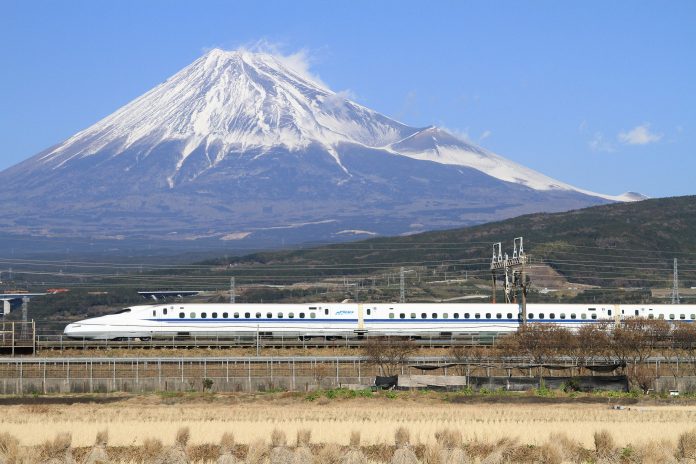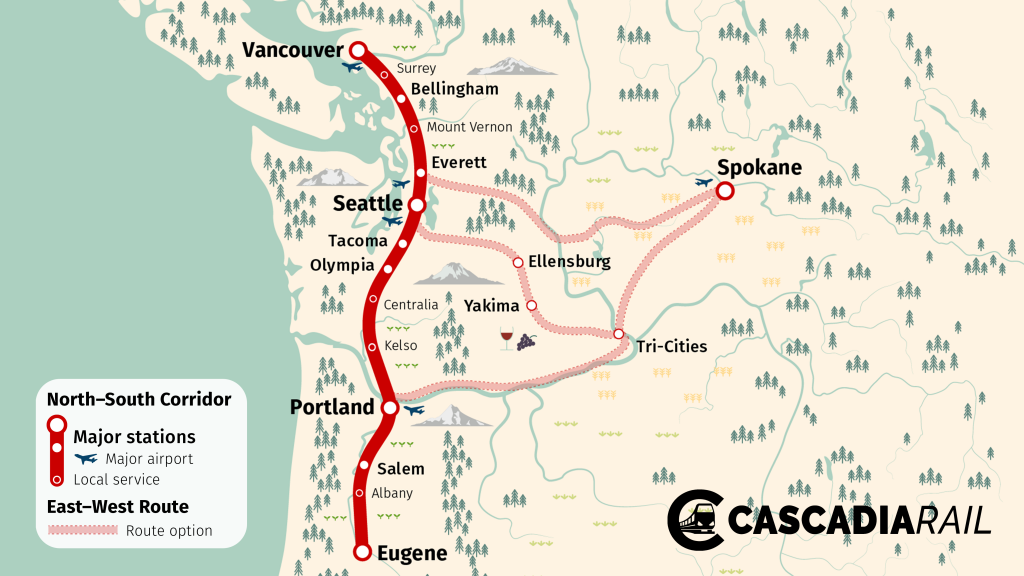
On Sunday, the Washington State Legislature concluded the 2019 legislative session. Many progressive environmental, transportation, land use, and housing bills managed to win approval and will become law. In our first installment to cover the legislative session wrap up, we provided an overview of key transportation bills that passed and did not pass this legislative session.
In this piece, we are covering significant policy proposals funded by the 2019-2021 biennium transportation appropriations bill (House Bill 1160). The appropriations bill will make $9.98 billion in transportation investments over the next two years, which is $300 million less than the governor’s $10.28 billion proposal.
Our next installment will focus on land use and housing bills, expanding on our coverage of the implications of real estate excise tax (REET) changes.
Groundwork laid for an interstate high-speed rail corridor authority
Significantly, the transportation appropriations bill will fund a signature policy priority of Governor Jay Inslee (D-Washington) to study what it would take to set up an interstate high-speed rail corridor authority. Up to $895,000 is authorized for the effort with $224,000 in direct state appropriations from the Multimodal Transportation Account. Another $671,000 will need to come from other partners like the Province of British Columbia, State of Oregon, and business interests–the core high-speed route is envisioned as linking the corridor from Portland to Vancouver, B.C., boosting business throughout. The state appropriation will not be released until funding from other partners is released, but it seems likely that the funding will come through. The governor, however, had requested several million dollars more for the effort.

Assuming the funding is formally secured in the coming months, the Washington State Department of Transportation (WSDOT) will be charged with the following tasks through 2020:
- WSDOT will be responsible for developing a governance structure to create an interstate high-speed rail corridor authority, including its powers, contracting requirements, and overall operating structure;
- WSDOT will need to conduct a review of laws, regulations, and agreements throughout Washington, Oregon, and British Columbia that may need to be changed or created to proceed with high-speed rail project development of the corridor; and
- WSDOT will need to provide other recommendations necessary to move ahead with project development of the corridor.
Recommendations by WSDOT will be due to the Washington State Legislature, Governor’s Office, and governments of Oregon and British Columbia by December 1, 2020.
Though not directly related to high-speed rail, the bill also directs WSDOT to “pursue efforts to reduce costs, increase ridership, and review Amtrak Cascades fares and fare schedules.”
Several transportation studies will be commissioned
The following studies will be funded by the biennial appropriations bill:
- $350,000 is earmarked for inventory and assessment of fish passage barriers.
- $450,000 is earmarked to study the transportation needs and priorities of the state over the next 10 years, which is due by June 30, 2020.
- $450,000 is earmarked to study and make recommendations on electrification of public agency fleets across Washington, which is due by September 30, 2020.
- $250,000 is earmarked to study a new intercity passenger rail corridor between Spokane and Auburn via Stampede Pass. Presumably, passengers would be able to transfer to existing Amtrak Cascades and Sound Transit South Sounder services for stations north and south of Auburn. The study is due by June 30, 2020.
- $250,000 is earmarked to study how tolling could be adjusted to provide discount or program to low-income motorists.
- $350,000 is earmarked for WSDOT to develop a transit-oriented development pilot project at the Kingsgate Park-and-Ride facility in Kirkland. The purpose of the pilot project is to demonstrate how WSDOT properties could be used for a variety of public purposes, aside from strictly transportation purposes. A report would need to be completed by December 1, 2019 to identify any legislative actions necessary to realize the pilot project. The pilot project would need to be completed by December 31, 2023.
- $84,000 is earmarked to study barriers to electric vehicle adoption by low-income residents.
- $250,000 is earmarked for Washington State Ferries (WSF) to study how to maximize sailings on the “Triangle Route” between Fauntleroy, Southworth, and Vashon. The goal of the study is to create a new schedule that will move the most passengers within the least time within financial and operational constraints. A report is be due by January 15, 2021.
- $350,000 is earmarked to study passenger-only ferry service between Puget Sound communities. The study will need to look at possible routes and terminals on Puget Sound, Lake Washington, and Lake Union and whether or not passenger-only ferry service would provide a net reduction in carbon emissions by passengers. The Puget Sound Regional Council will be charged with conducting the study and would need to provide a report by January 31, 2021.
- $700,000 is earmarked for the Ballard-Interbay Regional Transportation System Plan program.
The public transportation budget
As part of House Bill 2042 to advance adoption of green transportation, the transportation appropriations bill authorizes $62.7 million for grants to transit agencies and non-profit transportation providers to provide special needs transportation. $14.3 million of this will be grant for non-profit providers specifically and the remaining $48.4 million will be for transit agencies. Another $32 million will be available to rural communities for transit service under the Rural Mobility Grant Program. $12 million will be available under the Green Transportation Capital Grant Program to encourage public transit fleet electrification. The overall public transportation budget is set at $261.8 million over the biennium.
Local transit agencies will also receive several grants from the state, including some significant investments:
- $5 million for the Swift Green Line operated by Community Transit;
- $6 million for Pierce Transit to invest in its planned bus rapid transit corridor;
- $4.7 million for RapidRide improvements from Renton to Auburn via Kent;
- $4 million for Market Street and 45th Street RapidRide in Seattle;
- $10 million for the RapidRide H Line program;
- $4 million for the Roosevelt RapidRide project in Seattle;
- $4.5 million for Northgate station access and facility improvements;
- $6.6 million for King County Metro to build a bus layover facility on Eastlake Avenue;
- $1 million in investments for Metro on Route 40;
- $1.4 million for Metro to provide extra service on Route 101;
- $1.4 million for Metro spot improvements; and
- $1.5 million for Metro and Sound Transit to coordinate Link station integration.
Elsewhere in the state for transit and for the ferry system, the state intends to fund the following key projects:
- $4.9 million for C-TRAN in Vancouver to make bus on shoulder investments and $3 million for bus rapid transit;
- $3 million of Intercity Transit in Olympia to deploy a high performance bus corridor;
- $2.2 million for Skagit Transit to purchase commuter buses and expand operations;
- $5.3 million for Spokane Transit to make investments in a high performance bus corridors;
- $99 million for a new 144-car hybrid ferry for WSF; and
- $41.5 million for ferry electrification conversion for WSF.
However, the 2017-2019 biennium public transportation budget did receive a $27.6 million funding cut, mostly in the Regional Mobility Grant Program. The cuts reduced the public transportation budget from $236.8 million to $209.2 million.
Columbia River Crossing resurrected
The transportation appropriations bill authorizes a new effort to plan a Columbia River Crossing to replace the I-5 bridge. WSDOT will have $17.5 million on hand to cover staffing of the program. Department staff will be charged with working across state lines to coordinate the planning effort and engage stakeholders to develop a plan. The effort will also need to determine what a two-state governance structure will look like in order to effectively carryout decision-making, construction, and operation of a new bridge facility. Another $17.5 million will be available for pre-design work.
Stephen is a professional urban planner in Puget Sound with a passion for sustainable, livable, and diverse cities. He is especially interested in how policies, regulations, and programs can promote positive outcomes for communities. With stints in great cities like Bellingham and Cork, Stephen currently lives in Seattle. He primarily covers land use and transportation issues and has been with The Urbanist since 2014.

